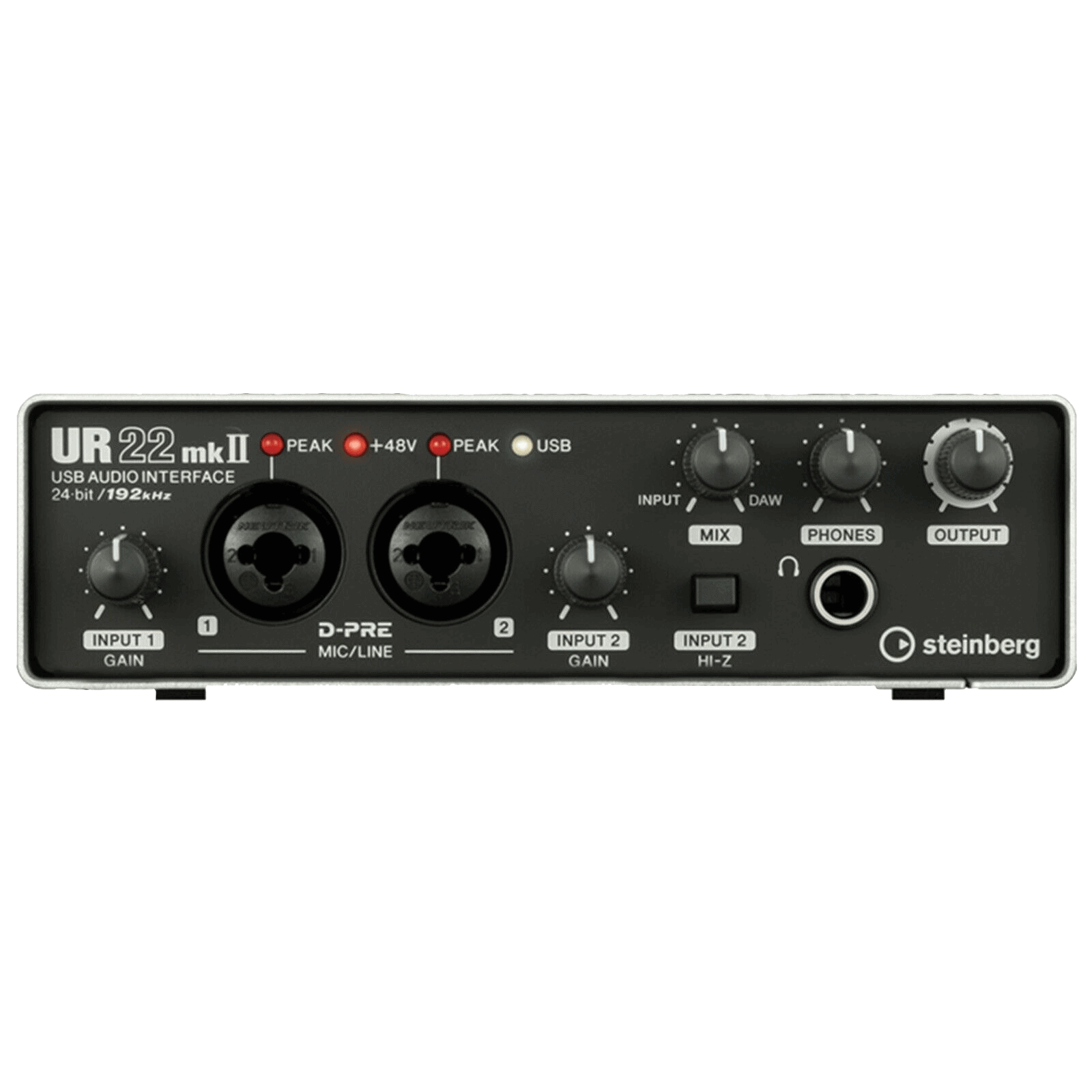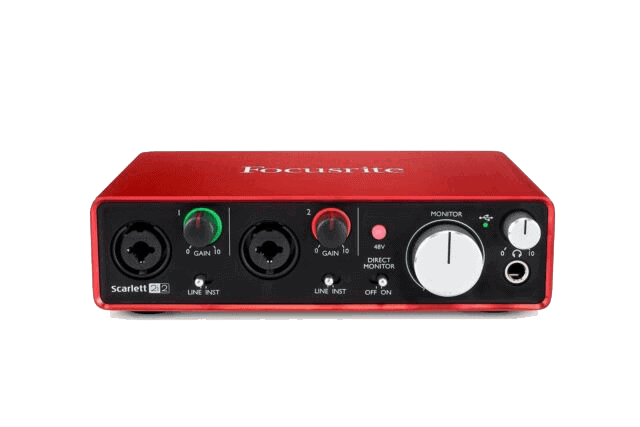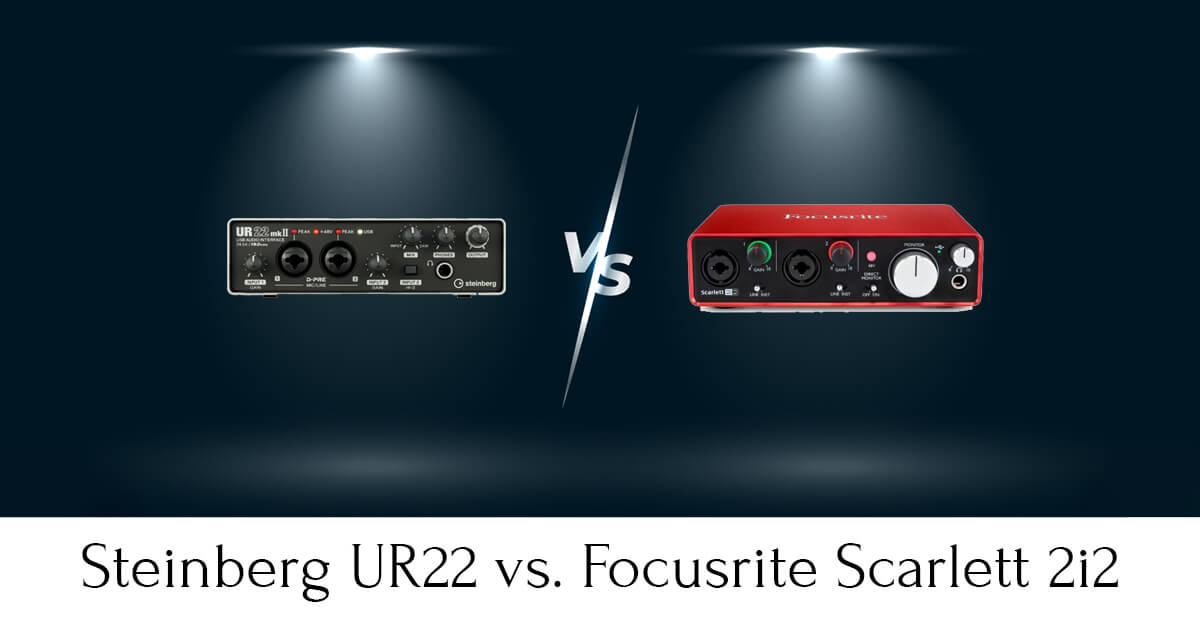If you’re looking to get the highest sound quality when recording your audio, there’s no way around an audio interface. What they do is convert signals coming from your instrument and microphone to a format that’s recognizable by computer software.
Obviously, with so much technology involved, finding the right device might be a little more difficult. But as a shortcut, in this article, I explore the Steinberg UR22 vs. Focusrite Scarlett 2i2, both of which are entry-level audio interfaces that don’t cost too much yet perform excellently.
Table of Contents
Steinberg UR22 vs. Focusrite Scarlett 2i2: Short Answer
The Steinberg UR22 is a more versatile tool, so it’s better for someone who is more experienced and is looking for plenty of functionality from their interface. But, if you’re an amateur, both of them would work just fine. Unless you’re willing to experiment a lot with software, then the 2i2 might have an advantage as it includes plenty of plug-ins and software choices. However, if you’re using a Windows 10 system, forget about the Scarlett 2i2 and stick with the UR22.
| Image | Product | Details | Price |
|---|---|---|---|
 |
Steinberg UR22 | Best for a Windows 10 System | Check Price |
 |
Focusrite Scarlett 2i2 | A Better Option in Terms of Portability | Check Price |
Specs at a Glance
Steinberg UR22
- 2 x Neutrik combo XLR/jack inputs that are capable of Phantom power
- 24-bit resolution
- 192 kHz sampling rate
- 2 x Yamaha D-PRE microphone preamps (Class-A)
- USB 2.0
Focusrite Scarlett 2i2
- 2 x Amphenol XLR/jack inputs that are capable of Phantom power
- 24-bit resolution
- 192 kHz sampling rate
- 2 x Focusrite analog preamps
- USB 2.0
Steinberg UR22 vs. Focusrite Scarlett 2i2: Full Comparison
There’s a lot of technical terms and jargon when it comes to audio interfaces, which is quite natural but hard to get a grasp on. To spare you the need to look every term up, here’s a breakdown of the specs and what they’re good for.
Design and Construction
Both interfaces come with a solid build with premium materials and dials, so you can count on them to last.
And while the UR22 gives you more usability in the front panel, this makes its interface a little cluttered. Not to mention the dials, all of which are placed to the right of the panel, come in the same size and shape, which makes it a little hard to differentiate between them when you’d like to adjust the parameters.
On the other hand, the 2i2’s design is a lot more user-friendly. You can easily be able to tell the difference between the black plastic gain dials and the much bigger silver monitoring and gain dials. On top of that, the gain dials produce a green light when there’s a signal passing through, and that light turns red during peaking.
As for Phantom toggling, the UR22 the light placed between the peak indicators, while the Focusrite distinguishes the button to send 48v to the inputs.
- Winner: Focusrite Scarlett 2i2.
Versatility
From the get-go, you can tell that you’ll get plenty of functionality out of the UR22. Its capabilities are as complex as its design, but this time, the complexity is in its favor. There’s a 5V DC power supply that you can use to ensure stability, especially if you opt for recording using an iOS device -a pretty cool option, in my opinion.
Also, the Steinberg UR22’s dial, which allows you to control just how much latency you get, which is definitely a huge plus, especially for vocal recording when you want partial reverb coming back to you. Not to mention, the DSP channel strip on the Steinberg allows you to add EQ and compression as you record live.
As for the Scarlett 2i2, there’s a downside to its direct monitoring as you can either set it to on or off. This means that it monitors directly from the interface instead of sending the audio through the DAW to be processed before coming back out. This is also known as zero-latency monitoring.
Also, the UR22 comes with MIDI in and out options on the back, which is definitely a huge plus if you have spontaneous composition sessions, though not essential for podcasting.
- Winner: Steinberg UR22.
Related: Behringer vs. Yamaha Mixers In-Depth Brand Comparison
Software
Despite not being very versatile when it comes to hardware, the Focusrite 2i2 is quite diverse in terms of software. It comes with Pro Tools First and Ableton Live Lite serial codes. This means that you get the 32 tracks, 16 audio ones, and 16 instruments ones, along with the ability to record 4 simultaneously.
Bear in mind that the Ableton Lite is a more basic version of the Ableton Live DAW, which gives you the space to test the waters with plenty of workflow scenarios in the case that you aren’t sure which DAW works the best for you.
On top of that, the Focusrite 2i2 comes with Red Plug-in Suite, Softube Time, and Tone. These plug-ins include reverb, delay, EQ, and compressors to enable you to produce and record crisp, clear, and high-quality sound.
As for the UR22, it comes with Cubase AI serial code for computers and Cubase LE for iOS. And while the Focusrite 2i2 beats it when it comes to the versatility of software, the UR22 has an edge in that it integrates iOS.
- Winner: Focusrite Scarlett 2i2.
Portability
The UR22 measures 8 x 9.25 x 4 inches and weighs around 3 pounds, while the Scarlett 2i2 measures 7.68 x 2.09 x 1.32 inches and weighs around 1 pound. Obviously, the Scarlett 2i2 is slimmer and lighter, so it’s considerably more portable.
But what the UR22 lacks in portability, it makes up for by how durable it is and how you can be sure that you can move it from one place to another without worrying about any damage.
- Winner: Focusrite Scarlett 2i2.
Price
The difference between the two isn’t that much, with the UR22 coming at around 10 or 20 bucks more than the Focusrite 2i2. However, this slight difference wouldn’t make a difference in budget, as both are entry-level devices anyway.
Still, for the price difference, the UR22 has much more functionality and durability to offer.
- Winner: Steinberg UR22.
Conclusion
There’s a chance that the decision was easy for you, and you’ll opt for the Steinberg UR22 because your computer runs on Windows 10.
If not, you should still seriously consider it as it offers a solid range of versatility when it comes to its functions and what you can do with it. It’s quite advanced that budget-conscious pros can go for it, especially with the iOS integration it has to offer.
However, if you’re looking for more versatility in terms of software and plug-ins, you’ll love what the Focusrite 2i2 has to offer. It’s also more user-friendly and intuitive in terms of interface. What’s more, it’s slimmer and lighter, so it might be the better option if you’re planning on recording from different locations frequently.

